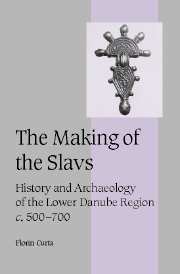Book contents
- Frontmatter
- Contents
- List of figures
- List of tables
- Acknowledgments
- List of abbreviations
- Introduction
- 1 Slavic ethnicity and the ethnie of the Slavs: concepts and approaches
- 2 Sources for the history of the early Slavs (c. 500–700)
- 3 The Slavs in early medieval sources (c. 500–700)
- 4 The Balkans and the Danube limes during the sixth and seventh centuries
- 5 Barbarians on the sixth-century Danube frontier: an archaeological survey
- 6 Elites and group identity north of the Danube frontier: the archaeological evidence
- 7 “Kings” and “democracy”: power in early Slavic society
- Conclusion: the making of the Slavs
- Appendix A
- Appendix B
- References
- Index
- Cambridge Studies in Medieval Life and Thought Fourth series
4 - The Balkans and the Danube limes during the sixth and seventh centuries
Published online by Cambridge University Press: 08 July 2009
- Frontmatter
- Contents
- List of figures
- List of tables
- Acknowledgments
- List of abbreviations
- Introduction
- 1 Slavic ethnicity and the ethnie of the Slavs: concepts and approaches
- 2 Sources for the history of the early Slavs (c. 500–700)
- 3 The Slavs in early medieval sources (c. 500–700)
- 4 The Balkans and the Danube limes during the sixth and seventh centuries
- 5 Barbarians on the sixth-century Danube frontier: an archaeological survey
- 6 Elites and group identity north of the Danube frontier: the archaeological evidence
- 7 “Kings” and “democracy”: power in early Slavic society
- Conclusion: the making of the Slavs
- Appendix A
- Appendix B
- References
- Index
- Cambridge Studies in Medieval Life and Thought Fourth series
Summary
No discussion of the early Slavs can avoid the very controversial issue of their role in the transformation of the Roman world that led to the “fall of the old order” and the rise of the new Empire, which historians call Byzantium. The withdrawal of the Roman administration and armies from the Balkans in the early seventh century is viewed by many as a result of the Slavic Landnahme. More often than not, accounts of the early Slavic history focus on the destruction brought by the invading hordes to the flourishing cities of the Balkans. The classical urban culture was unable to survive the strain of the barbarian invasions. As with the Germans in the West, the Slavic “obscure progression” led to the slow dissolution of the Roman frontier and the Empire finally succumbed to the growth of forces beyond its control.
The existing evidence, written or archaeological, does not confirm this over-simplified picture. Long before the first Slavic raid attested by historical sources, the urban landscape in the Balkans began to change. It is clear, however, that some change was also taking place in the Balkans at the time of Slavic and Avar raids. The remaining question is whether or not the Slavs can be made responsible. Emphasizing almost exclusively the Roman side of the story, historians also neglected the equally important question of the Roman influence on the “invading” barbarians.
- Type
- Chapter
- Information
- The Making of the SlavsHistory and Archaeology of the Lower Danube Region, c.500–700, pp. 120 - 189Publisher: Cambridge University PressPrint publication year: 2001

